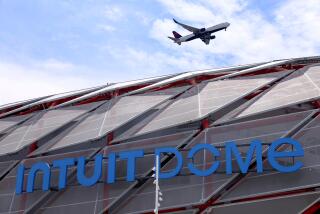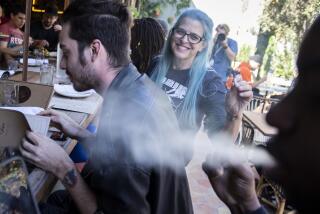Smoke Set to Clear in Bars--But Will It?
- Share via
SACRAMENTO — If all goes according to law, as the clock strikes midnight on New Year’s Eve, bartenders at California’s 35,596 saloons will ask their patrons to snuff out their smokes, then gather up the ashtrays.
If the patrons comply, California will be transformed into the first state in the nation with smoke-free bars and casinos.
Those are two big ifs. Although anti-smokers hail the step, seeing bars as a major hurdle toward ridding public places of tobacco fumes, smokers are fuming.
“The pleasure police are at it again,” said Harold Maltz, manager of Wally’s Cigar Box in Westwood.
A lawsuit has been filed by Bay Area casinos to block the law’s enforcement. Some bar and casino owners, fearing a drop in business, are consulting with lawyers in search of loopholes.
Some hold out hope that the Legislature will reverse itself and lift the law, though that’s unlikely. A few die-hards predict that smokers, having been driven from offices, movie theaters, restaurants and in some instances their own homes, will simply ignore this latest lung-saving effort.
“Smokers have willingly given up the office, most workplaces, airplanes, airline terminals, school campuses and restaurants,” said Assemblyman Brett Granlund (R-Yucaipa), who describes himself as the Legislature’s “most notorious smoker,” albeit one whose New Year’s resolution is to kick the habit.
“I don’t believe they’re going to give up bars,” Granlund added. “I don’t believe a nonsmoker has any concept of the urge to smoke and how strong that physical addiction is when complemented with a couple of beers.”
Bars the Last Haven for Smokers
Anti-smoking advocates believe that if California’s attempt to stop smoking in bars works, more states will attempt to limit workplace smoking.
“This is real change,” said Stanton Glantz, a medical school professor at UC San Francisco and a leader in the anti-tobacco movement. “Bars are so clearly viewed as the toughest place and last bastion. The fact that a place as big and diverse as California can do this will embolden other places.”
To drum up support, the state Department of Health Services is airing television and radio ads. The ads portray waitresses bemoaning smoke and pointing out that restaurant and bar workers have especially high cancer and heart attack rates.
There has been widespread compliance with the statewide restaurant smoking ban that took effect in 1995. That gives hope to Colleen Stevens of the state health department’s tobacco control section that the smoking ban in bars will take hold.
Although acknowledging that the prohibition on smoking in bars and card rooms will not be a “cakewalk,” Stevens pointed out that of California’s 35,596 businesses licensed to serve drinks, 30,724 also serve food.
“We know there is an incredible demand among smokers and nonsmokers that they do not want smoke around when they eat,” she said. “It will just become the norm. People will go outside to smoke.”
The Legislature approved and Gov. Pete Wilson signed California’s indoor workplace smoking ban in 1994, despite one of the most intense lobbying efforts ever mounted by the tobacco industry and its allies.
Then-Assemblyman Terry Friedman of Los Angeles, the measure’s author, cast the bill as a worker-protection measure. It attempts to protect workers’ health by prohibiting smoking in almost all enclosed workplaces, ranging from offices and auto garages to restaurants.
To win votes, Friedman had to compromise. One such compromise was to exempt bars and casinos for two years. The compromise also called on the California Occupational Safety and Health Administration to write standards for safe levels of tobacco smoke exposure, but didn’t require it. If safe levels could be set, smoking could continue in the establishments.
Cal/OSHA did little to draft such a standard because there may be no safe exposure level.
John MacLeod, executive officer of the Cal/OSHA standards board, said any smoking safety standards would have to be written so that there would be an “insignificant” threat to employees from smoke.
“There have never been any permissible exposure levels developed for environmental tobacco smoke,” MacLeod said. “It would be nearly impossible. Tobacco smoke . . . consists of over 3,000 compounds, which makes it all the more challenging.”
Meanwhile, separate legislation approved in 1996 allowed smoking in bars for another year. Bills to grant yet another extension failed this year, thus leaving the ban in place as of Jan. 1.
Two Bay Area casinos, hoping to stop the ban from taking effect, filed a lawsuit against Cal/OSHA earlier this month demanding that it set the safety standards. The case is scheduled to be heard Jan. 8 in San Francisco Superior Court.
If the judge orders that Cal/OSHA develop the standards, the ban could be put on hold in card rooms and bars, said lawyer Gary P. Vannelli, who represents Artichoke Joe’s casino in San Bruno.
“I don’t have on rose-colored glasses. It’s going to be tough,” Vannelli said. But, he added, “I believe we have a shot at it.”
If the suit fails, Vannelli predicts, casinos will lose business, particularly if players live close to casinos on Indian land, where state law does not reach. As it now stands, bars and casinos on Indian land will be one of the few enclosed workplaces where smoking can be permitted in California.
In most of the rest of California, the law requires that business owners or managers ask a smoking patron to snuff out a cigarette or cigar.
The proprietor is not obligated to evict a patron who continues to smoke.
But if someone files a complaint, the business owner, not the smoker, is liable for the fine--$100 for the first violation, $200 for the second, $500 for the third, and a referral to Cal/OSHA, which can impose $7,000 fines.
State Alcoholic Beverage Control inspectors also will begin noting violations as part of their inspections.
A Hodgepodge of Enforcement
Until now, fines for violating the indoor smoking ban have been rare.
Most restaurants and other affected businesses complied when the initial ban went into effect in 1995, authorities who enforce the law say. Authorities expect that the change won’t be quite as smooth in bars.
“The smoking ban in bars is going to be more interesting. It’s a different context,” said Ingrid Lamirault, director of the Los Angeles County Health Department’s tobacco control program.
Under the law, enforcement is left to cities and counties. In some locales, police will enforce it. In others, the health department will. Some cities have assigned it to their code enforcement inspectors.
Authorities responsible for enforcing the law say they intend to emphasize education, telling bar owners about the health benefits of the smoking ban.
The Los Angeles County Department of Health Services, which is responsible for enforcing the law in county areas, has embarked on such an education campaign, supplying bars with no-smoking signs, pamphlets describing the ill effects of secondhand tobacco smoke, even cocktail napkins with anti-smoking slogans such as “Cheers to smoke-free bars.”
In the city of Los Angeles, there’s a number to call with complaints. A recording asks for details about the violation and the name of the person making the complaint. How well it works could not be determined. No one returned The Times’ calls for this story.
Los Angeles police might respond to such complaints, though LAPD spokesman Lt. Anthony Alba said a smoking violation “would be a low priority in terms of calls for service, emergencies being first.”
Loophole if Bar Has No Employees
The city of San Francisco appears to have one of the better plans for enforcement. Health department officials there have been meeting with bar owners, and authorities have prepared a detailed explanation of what the law requires.
Jack Breslin, who heads the San Francisco Department of Public Health’s inspection section, said his 25 inspectors will be making sure bars have posted no-smoking signs and checking to make sure there are no ashtrays--though, Assemblyman Granlund and others note, the law does not direct that business owners collect ashtrays.
“There is no reason for ashtrays if there is no smoking,” Breslin said.
Breslin expects to spend at least the month of January and possibly longer making sure bar owners understand the law, and will only recommend fines in extreme cases.
“We’re going to give them ample warnings before we start dipping into their pockets,” Breslin said.
Critics of the ban are predicting widespread violations. Bar owners and smoking patrons also are circulating petitions--to be forwarded to Sacramento--in an effort to persuade lawmakers to lift the ban.
One of the organizers is Granlund. He has been meeting with bar owners in his Inland Empire district and distributing fliers pointing out some of the law’s exemptions.
“When your own wife and children run you out of the home, you’ve got the Elks Lodge or VFW or the bar,” Granlund said. “This is the place where smokers stand up and say, ‘No more.’ ”
Granlund and others noted that the law doesn’t extend to bars that have no employees. So owner-operators can permit smoking.
Some bar owners are mulling over making employees part owners, although that would leave the employees without other protections written into labor law. Others are contemplating knocking out a wall, so their bars no longer would be “enclosed.”
At the Occidental Grill in San Francisco’s financial district, owner Curtis Post is working on leasing a building next door where his cigar-smoking clientele could find sanctuary. No employees would be allowed in the room, and it would have separate ventilation.
Even so, Post expects a 25% drop in business.
“It’s our market niche. We cater to it,” Post said. “We serve fine steaks, hand-shaken martinis and cigars.” He has two portable humidors, which waiters bring to customers’ tables. “Even though we still will be able to sell [cigars], we can’t smoke them.”
At Hank’s, a bar on Grand Avenue in downtown Los Angeles, the debate rages. Don Andrews, who helps out with various chores, predicts “it’s going to kill the bars.” He can’t imagine asking a drinker to put out a cigarette--”unless you want to wind up in the hospital.”
Owner Telokjan Gill, by contrast, shrugged off the change: “So we will lose a few clients. There will be others coming. There’s nothing like your health.” Customers may leave, he said, but they will be back--”don’t worry.”
(BEGIN TEXT OF INFOBOX / INFOGRAPHIC)
So, Where Can You Smoke?
It’s a New Year’s resolution on a grand scale: End smoking in bars and casinos. Though a legal challenge is pending, as of Jan. 1, here’s where Californian’s can still smoke, other than their homes and cars and outdoors.
* Bars and casinos on Indian land.
* Bars or other establishments that are owner-operated and have no employees.
* Bars or other establishments not enclosed by four walls and a ceiling.
* Patios outside bars, restaurants or other workplaces.
* Designated areas in hotel lobbies.
* Hotel rooms set aside for smokers.
* Truck cabs if no nonsmoking employees are present.
* Private smoking lounges attached to tobacco retailers.
* Tobacco shops.
* Some buildings on federal land, such as clubs on military bases, though many of these buildings will go smoke-free later in 1998.
* Theatrical production and movie sets when smoking is part of the production.
* Warehouses of more than 100,000 square feet with fewer than 20 employees.
* Medical research or treatment sites where smoking is part of the research.
* Businesses with five or fewer employees where all employees consent, children are not allowed and the building is vented. This does not apply to bars, but does to adult book shops.
Source: California Department of Health Services, San Francisco Public Health Department.
More to Read
Sign up for Essential California
The most important California stories and recommendations in your inbox every morning.
You may occasionally receive promotional content from the Los Angeles Times.













